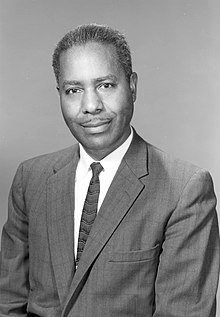Walter McAfee
Walter McAfee | |
|---|---|
 Walter S. McAfee during his time serving as a scientist for the U.S. Army Communication-Electronics Command. | |
| Born | September 2, 1914 Ore City, Texas, US |
| Died | February 18, 1995 (aged 80) |
| Nationality | American |
| Alma mater | Wiley College Ohio State University Cornell University |
| Known for | Project Diana |
| Scientific career | |
| Fields | Astronomy |
| Institutions | Fort Monmouth, New Jersey Monmouth University |
| Doctoral advisor | Hans Bethe |
Walter Samuel McAfee (September 2, 1914 – February 18, 1995) was an American scientist and astronomer, notable for participating in the world's first lunar radar echo experiments with Project Diana.[1][2]
Personal life[edit]
McAfee was born in Ore City, Texas to African-American parents Luther F. McAfee and Susie A. Johnson; he was the second of their nine children. At three months old, the family moved to Marshall, Texas, where McAfee would grow up and attend undergraduate school. He graduated high school in Marshall in 1930, and later noted that his high school physics and chemistry teacher, Freeman Prince Hodge, was a great influence of his. Following the completion of his master's degree, McAfee took a job in 1939 teaching science and mathematics in Columbus, Ohio.[3] In 1941, he married Viola Winston, who taught French at the same junior high school in Columbus, Ohio where McAfee taught.[4] McAfee and Winston had two daughters.[5] McAfee died at his home in South Belmar, New Jersey, on February 18, 1995.[3]
Education[edit]
McAfee attended Wiley College, where his mother studied, graduating with a B.S. in mathematics in 1934. Following his undergraduate work, McAfee attended Ohio State University and earned his M.S. in physics in 1937. After his work on Project Diana with the United States Army Signal Corps Engineering Laboratories, McAfee returned to school, receiving the Rosenwald Fellowship to continue his doctoral studies at Cornell University.[6] In 1949, McAfee was awarded his PhD in Physics for his work on nuclear collisions under Hans Bethe.
In 1956 President Dwight D. Eisenhower presented him with one of the first Secretary of the Army Research and Study Fellowships. The fellowship enabled McAfee to spend two years studying radio astronomy at Harvard University.[7]
Biography[edit]
McAfee left his teaching position in Ohio when he was hired by the Army Signal Corps to work at the Electronics Research Command at Fort Monmouth, New Jersey, in May 1942.[8] It was here that he participated in Project Diana,[3] completing the first calculations showing that radar signals could be successfully bounced from a ground-based antenna to the Moon and back; this prediction was verified experimentally in 1946.
During his time at Fort Monmouth, he lectured in physics and electronics at Monmouth College (now Monmouth University) from 1958 to 1975, and served as a trustee at Brookdale Community College.[7] McAfee also served on the Curriculum Advisory Council of the Electronics Engineering Department at Monmouth and was recognized with an honorary doctorate of science in 1985.[7]
Honors and awards[edit]
In 1961, McAfee received the first U.S. Army Research and Development Achievement Award. He was eventually promoted to GS-16, the highest civilian rank achieved to date by any African-American person. After his death a research building at Aberdeen Proving Ground was named in his honor (2011) and he was inducted into the Army Material Command's Hall of Fame (2015).
Selected publications[edit]
- Walter S. McAfee. Determination of energy spectra of backscattered electrons by use of Everhart's theory. Journal of Applied Physics 47, 1179 (1976); https://doi.org/10.1063/1.322700.
- Gerald J. Iafrate, Walter S. McAfee, and A. Ballato. Electron backscattering from solids and double layers. Journal of Vacuum Science and Technology 13, 843 (1976); https://doi.org/10.1116/1.569000.
References[edit]
- ^ "Astronomers of the African Diaspora". University of Buffalo. Retrieved February 21, 2013.
- ^ Pomerleau, Cindy Stodola (2021). To the Moon and Back: Essays on the Life and Times of Project Diana. pp. 86–90. ISBN 979-8-706-54632-8.
- ^ a b c Spangenburg, Ray; Moser, Diane (2003). African Americans in Science, Math, and Invention. Infobase Publishing. p. 175. ISBN 9781438107745.
- ^ O'Connor and Robertson. (April 2002). "Walter Samuel McAfee". MacTutor History of Mathematics Archive. Retrieved June 10, 2020.
- ^ "First African-American enters AMC Hall of Fame". www.army.mil. Retrieved June 11, 2020.
- ^ "Walter McAfee". www.nsbp.org. Retrieved June 10, 2020.
- ^ a b c "Honoring the Legacy of Walter S. McAfee '85HN". Monmouth University. Retrieved February 21, 2022.
- ^ Ziobro, Melissa. "Dr. Walter McAfee: Camp Evans Mathematician, Scholar, and Scientist". Monmouth Timeline. Retrieved February 21, 2022.
